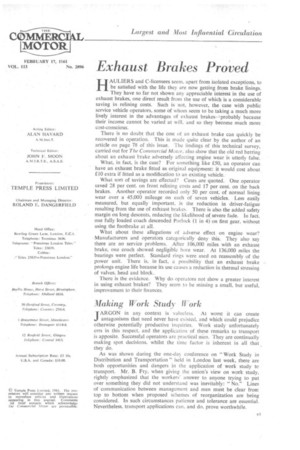Exhaust Brakes Proved
Page 35

If you've noticed an error in this article please click here to report it so we can fix it.
HAULIERS and C-licensees seem, apart from isolated exceptions, to be satisfied with the life they are now getting from brake linings. They have so far not shown any appreciable interest in the use of exhaust brakes, one direct result from the use of which is a considerable saving in relining costs. Such is not, however, the case with public service vehicle operators, some of whom seem to be taking a much more lively interest in the advantages of exhaust brakes—Iprobably because their income cannot be varied at will, and so they become much more cost-conscious.
There is no doubt that the cost of an exhaust brake can quickly be recovered in operation. This is made quite clear by the author of an article on page 78 of this issue. The findings of this technical survey, carried out for The Commercial Motor, also show that the old red herring about an exhaust brake adversely affecting engine wear is utterly false.
What, in fact, is the case? For something like 00, an operator can have an exhaust brake fitted as original equipment: it would cost about CEO extra if fitted as a modification to an existing vehicle.
What sort of savings are effected? Cases are quoted. One operator saved 28 per cent. on front relining costs and 17 per cent. on the back brakes. Another operator recorded only. 50 per cent. of normal lining wear over a 45,000 mileage on each of seven vehicles. Less easily measured, but equally important, is the reduction in driver-fatigue resulting from the use of exhaust brakes. There is also the added safety margin on long descents, reducing the likelihood of severe fade. In fact. one fully loaded coach descended Porlock (1 in 4) on first gear, without using the footbrake at all.
What about these allegations of adverse effect on engine wear'? Manufacturers and operators categorically deny this. They also say there are no service problems. After 106,000 miles with an exhaust brake, one coach showed negligible bore wear. At 136,000 miles the bearings were perfect. Standard rings were used on reassembly of the power unit. There is, in fact, a possibility that an exhaust brake prolongs engine life because its use causes a reduction in thermal stressing of valves, head and block.
There is the evidence. Why do operators not show a greater interest in using exhaust brakes? They seem to be missing a small, but useful, improvement to their finances.
Making Work Study frork
T ARGON in any context is valueless. At worst it can create antagonisms that need never have existed, and which could prejudice otherwise potentially productive inquiries. Work study unfortunately errs in this respect, and the application of these remarks to transport is apposite. Successful operators are practical men. They are continually making spot decisions, whilst the time factor is inherent in all that they do, As was shown during the one-day conference on "Work Study in Distribution and Transportation "held in London last week, there are both opportunities and dangers in the application of work study to transport. Mr. B. Fry, when giving the union's view on work study, rightly emphasized that the workers' answer to anyone trying to put over something they did not understand was inevitably: "No." Lines of communication between management and men must be clear from top to bottom when proposed schemes of reorganization are being considered. In such circumstances patience and tolerance are essential. Nevertheless, transport applications Can, and do. prove worthwhile.




















































































































